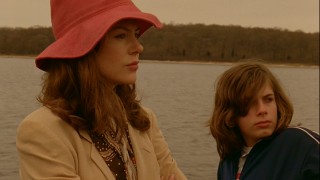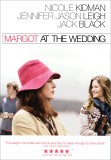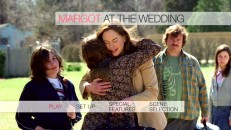By Christopher Disher
Noah Baumbach continues writing and directing with the often attempted but usually botched dysfunctional family plot of his most recent film Margot at the Wedding. After gaining notice on a trio of small independent movies made in his late 20s, Baumbach collaborated with pal Wes Anderson on 2004's The Life Aquatic with Steve Zissou. He then went on to write and direct the critically acclaimed low-budget feature The Squid and the Whale (2005), a story heavily inspired by his own childhood.
From the effectiveness of Squid, it is easy to extrapolate that its maker is somewhat of an expert in the psychology and pathology of the dysfunctional family, simply by virtue of experiencing it firsthand and channeling it to the screen.
Margot at the Wedding is a nuanced and anecdotal tale of the modern faulted family. The story sets off when the neurotic Margot (Nicole Kidman) and her dry, plain speaking son Claude (Zane Pais) make a surprise visit to her sister's in anticipation of her wedding. In returning to her childhood home, where sister Pauline (Jennifer Jason Leigh) still resides, Margot brings back all of the criticism, cynicism, and selfishness that originally frustrated the siblings' relationship years ago. The plot unfolds like a balled-up sweater with no clear direction or purpose. The characters lack motivation as they bite at each other's ankles. Pauline's fiancé Malcolm (Jack Black) often ends up the target of all deviant behavior, though he begins as the only untainted soul in the spoiled bunch.


Slowly the layers peel away and the true characters shine through. Margot entertains the possibility of a relationship with an author (Ciarán Hinds) she is in collaboration with. The interest comes mostly out of convenience and opportunity rather than desire. The things Margot says to her husband (a briefly seen John Turturro) would turn anyone away from this sullied mother. Claude, a boy on the brink of puberty, never appears the victim in the relationship with his unstable mother. Rather, he is a non-aggressor who floats between the women in the house, never sure what his relationship with them is supposed to be. He and Margot have a relationship that would be dubbed incredibly awkward by any normal child of his age. As the characters' narcissism deepens, even this close mother-son connection pulls apart. Malcolm, the family outsider, remains the only voice of reason, appearing both stable and normal until it is revealed that he too has a dark secret.
Ultimately, the broken cogs in the family are never fixed or fully identified. We can label Margot as the sour apple who ruins the whole batch, but a leap is never made beyond that. Still, a quiet satisfaction lingers after watching the film. Perhaps the feeble structure and lack of conventional plot mechanisms make for a confused response that -- simultaneously coupled with the powerful portrayal of a dry, broken family -- delivers a somewhat meaningful experience. The verisimilitude is the tale's strong point and even though the characters constantly seem sedated, their moments of expressed emotion are effective and engaging and do well to hold interest.


Like Baumbach's other films, Margot failed to bring in the cash at the box office. It has yet to be released overseas, but its homeland gross of under $2 million disappointed, even while limited to just 121 theaters. Video sales and rentals have a lot of slack to pick up to make the estimated $10 million film profitable.
Standing back and regarding the film as a whole, it seems as though it communicates in another language; I can hear the way the words are said and I understand the speakers' intentions but I can't grasp their meaning. Even so, Margot is worth watching simply for its ability to be refreshingly different without being fatally flawed.
 |
DVD Details
1.78:1 Anamorphic Widescreen
Dolby Digital 5.1 (English, Spanish)
Subtitles: English, French, Spanish
Closed Captioned; Featurette Subtitled
Release Date: February 19, 2008
Suggested Retail Price: $29.99
Single-sided, dual-layered disc (DVD-9)
Black Keepcase with Side Snaps |
VIDEO and AUDIO
Cinematographer Harris Savides has directed photography on many visually compelling films; American Gangster and Birth are two recent examples. He has also worked with Gus Van Sant on Elephant, another offbeat movie with a raw look to it that opposes the standard Hollywood gloss found in many traditional pictures.
On Margot, he reverts to the low-budget indie look and sacrifices pleasant lighting for a more natural, almost Danish Dogme appearance. Consequently, the lighting is terrible in some night scenes; characters' faces are barely lit or not lit at all during many of these scenes.
The transfer to DVD appears faithful to the original, but there is no real way to tell. The blacks have little depth and overall there isn't much contrast in the picture. Still, the 16x9 presentation is clean.
Both English and Spanish tracks are offered in Dolby Digital 5.1. The same philosophy for cinematographic integrity is present in the sound design, which comes mostly from the natural environment. There are few sound effects and the overall mix does not draw attention to itself. It makes minimal use of the 5.1 speaker set-up. The center channel could be strengthened as the characters talk quietly and often mumble with no boost in audio level to compensate.



BONUS FEATURES, MENUS and PACKAGING
The disc has a paltry selection of special features, the only real item being a conversation with Noah Baumbach and his wife/actress Jennifer Jason Leigh (12:55).
It is always interesting to see actors enter the indie world with a bold, off-beat script at the helm. Both Nicole Kidman and Jack Black surprised with thoroughly convincing performances that showed emotional sincerity and confidence in their roles. This short interview with Baumbach and Leigh sheds light on the capabilities of the actors, the approach to directing them, and the overall experience in general.
The other offerings are two theatrical trailers from the film (2:35 and 1:43) and a selection of previews from Into the Wild, Things We Lost in the Fire, The Heartbreak Kid, There Will Be Blood, and Kite Runner (11:38). The trailers play together on one track but are navigable with the chapter button.
The main menu plays for nearly a minute with a slideshow of film stills fading in and out to the Ken Burns effect, all atop some natural sound of trains. The submenus are static and without sound.


CLOSING THOUGHTS
Margot at the Wedding works well because of the chemistry between the characters. It is, essentially, about them unraveling because of their cocktail assortment of personality disorders, substance abuse, and past secrets. It is not a film for anyone wishing for the traditional story structure. With an open mind and little expectation, Margot should make for a delightfully disturbing experience.
More on the DVD / Buy from Amazon.com












